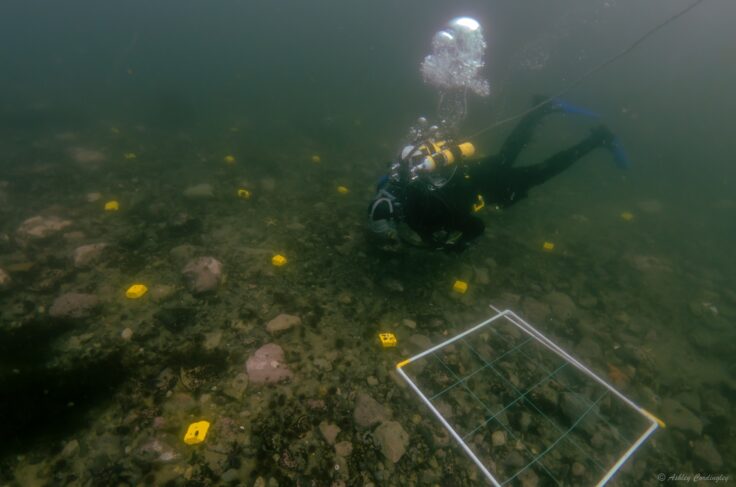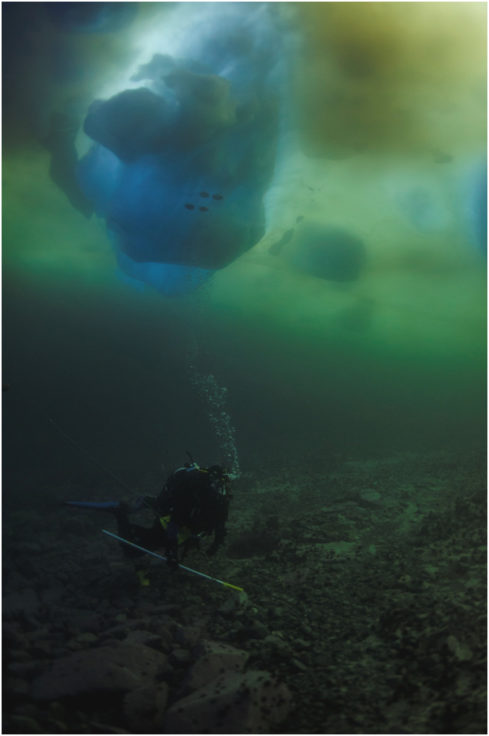Iceberg scouring disturbs carbon-fixing seafloor ecosystems
Shallow-water ecosystems are a major carbon sink, as many species living on the seafloor use carbon to build their tissue and shells. This carbon can become part of seafloor sediment layers when the animals die and are buried, so it is removed from circulation. As a result, seafloor ecosystems may help offset global CO2 emissions and resulting climate change.
Around the Antarctic Peninsula, though, growing numbers of icebergs scour the seafloor in shallow waters, destroying the ecosystems that live here. This reduces the otherwise huge potential for seafloor ecosystems to soak up carbon from the ocean.
Along the western Antarctic Peninsula’s coastline alone, seafloor ecosystem disturbance by icebergs may prevent up to 80,000 tonnes of carbon from being sequestered into sediments. Writing in Global Change Biology this week, David Barnes, a marine ecologist at British Antarctic Survey (BAS), reports that as climate changes and the sea surface freezes less in winter, the potential for iceberg-seabed collisions has increased significantly over the past decade.
As ice-free periods in summer grow longer in the waters surrounding West Antarctica, algal blooms can flourish for longer time periods. These algae provide food for seafloor ecosystems, which can therefore grow more each year – and fix more carbon in the process. But the presence of open water also means that icebergs, which break off from glaciers flowing into the sea, can move around freely and scour shallow seafloors.
In the longest-running study of its kind, BAS scientists and divers have been monitoring the seafloor of Ryder Bay, near Rothera research station on the Antarctic Peninsula, since 2003. In the 13 years since, nearly a third of all monitored locations were hit by moving icebergs every single year. Just 7% of locations were not hit by icebergs at all during the study period.

Dr Barnes said, “We knew that life on the polar seabeds was globally important in storing carbon, but this study shows that the shallows are particularly important. Unfortunately, icebergs hamper this process in Antarctica by damaging and ‘grinding up’ the seafloor and its inhabitants.”
Seafloor ecosystems need years to decades to recover from iceberg impacts. However, almost none of the study locations were undisturbed for more than 4 years in a row. The shallowest parts of the seafloor were the most affected, since there are more icebergs big enough to reach the bed here. An average square metre was hit more than three times a decade at 5m, decreasing to once a decade at 25m depth.

The work is a prelude to a new project involving scientists from six countries mapping seabed carbon around Antarctica on the Antarctic Circumnavigation Expedition. Since 2006, Dr Barnes’ study finds that the seafloor ecosystem in Ryder Bay has entered a high-mortality phase resulting in reduced carbon uptake.
Dr Barnes comments, “When glaciers in the region retreat out of the ocean, iceberg numbers will reduce. At that point, we may see a huge boost in shallow seafloor carbon storage.”
The paper, Iceberg killing fields limit huge potential for benthic blue carbon in Antarctic shallows by David K.A. Barnes, is published in Global Change Biology.